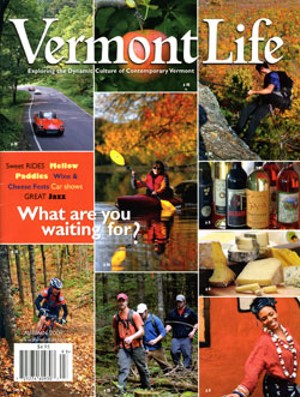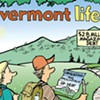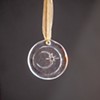Published October 7, 2009 at 6:06 a.m.
You’d never know from looking at the pretty pages of Vermont Life magazine that some ugly accusations were leveled at the state-owned publication last week. The group of citizens charged by the legislature with guiding and protecting the quarterly magazine presented a letter to the state agency that oversees it, listing a number of concerns they believe threaten Vermont Life’s existence. Their worries range from inadequate financial oversight to a new editorial vision they say could alienate the core base of subscribers.
In a sharply worded letter that was hand-delivered on September 29 to Commerce Secretary Kevin Dorn — and cc’ed to Governor Jim Douglas and Secretary of Administration Neale Lunderville — the Vermont Life advisory board criticized a number of crucial business and editorial decisions that have been made at the publication without the board’s knowledge, including “radical changes in the story and photo concepts.” The group doesn’t like the fact that the magazine is operating without a professional publisher, either. Tom Kelly was let go in May, along with Vermont Life’s longtime marketing manager.
In the intervening weeks, the magazine’s “managers” made two decisions that surprised and stunned the volunteers who are supposed to be guiding it: Dorn’s Agency of Commerce and Community Development terminated a contract with Smart Communications, a local marketing firm that has been selling ads in Vermont Life for 18 years; and the magazine staff missed the traditional deadline for distributing the catalogue that drives holiday sales of books, calendars and other lucrative products that account for one-third of Vermont Life’s $1.8 million annual revenue.
“We’ve spent a lot of time building these revenue streams, and now we’re just taking this big risk with them,” says Vermont Life advisory board chair Steve Wood, whose day job involves managing assets at National Life. “The recession alone would be bad enough, but the recession coupled with a whole new dynamic in media delivery creates enormous challenges. We’ve worried to ourselves that our friends who manage the magazine may not even be aware of what some of these risks are,” Wood continues. “That’s why we felt we had to speak up … We’re determined to not be rubber stamps for something we don’t agree with.”
Wood represents Vermont Life advisory board colleagues Pennie Beach of Basin Harbor Club, Paul Bruhn of Preservation Vermont, journalist Fran Stoddard, veteran broadcaster and businessman Brian Harwood, Laura Carlsmith from EatingWell magazine and Jack Crowl, former publisher of the Chronicle of Higher Education. All seven members of the group signed the letter that was presented to Dorn.
“Vermont Life is not theirs to destroy,” Wood says of Dorn’s agency. “It’s not ours, either … But, for better or worse, someone saw fit to designate us a group of Vermont citizens who play the role of being advisors to those who are managing this asset that belongs to the people of Vermont.”
In that spirit of stewardship, Wood warns, “We have a real sense that we’re sailing this ship in the fog, and we’re hoping and praying we don’t hit anything … It’s a very fragile ship, and it can’t take too hard a blow.”
*****
Since the state created a quarterly magazine in 1946 to promote Vermont’s virtues in four-color splendor, Vermont Life has become something of an anomaly in the publishing world: a product of the tourism department that maintains enough editorial independence — protected by state statute — that people will pay to read it. Over the years, the photo-filled magazine has won numerous writing and design awards.
There have even been periods in its 63-year history when the publication was totally self-supporting, primarily as a result of Vermont Life calendar sales.
“The first 20 years it got a state appropriation, the second 20 years it made money, and the next 20 years, it got more complicated,” says Tom Slayton, who served as editor and publisher of Vermont Life for 22 years. In 1991, after three years of state deficits, the publication made the decision to accept paid advertising. There were plenty of complaints at first, but in 1994, Vermont Life won the “Most Improved Magazine” award from the International Regional Magazine Association.
The publishing business has become a lot more challenging since Slayton was steering Vermont Life. So much so that when he retired in 2007, Slayton encouraged the state to hire two people to mind the business and the content sides of the magazine. Although technological advances have made some of the production processes easier, Vermont Life has to contend with the same forces that have shuttered other publications: declining ad revenues and increased competition for readers, in print and online.
Vermont Life established a website back in the 1990s. But by today’s standards, it’s sorely lacking. Editor Mary Hegarty Nowlan, 42, describes it as an “embarrassment.” The magazine’s catalogue of products is not offered online, nor can a visitor search there for information about Vermont inns and restaurants, even though the Department of Travel and Tourism, which oversees Vermont Life, has all that functionality. Want to order over the phone? Vermont Life’s in-house call center is only open during state business hours, from 7:45 a.m. to 4:30 p.m.
Nowlan is well aware of her magazine’s commercial shortcomings, and she acknowledges that a couple of balls have been dropped since Kelly left in May. “I’m doing the best I can,” she says, pointing out that she was not hired to handle the money side of the operation. She credits Steve Cook, who has been on loan from Travel and Tourism, with assisting her in numerous revenue-generating “publisher” projects, including a total overhaul of the Vermont Life gift catalogue.
In their letter to Dorn, the advisory board members noted with great concern that the holiday gift catalogue traditionally goes out with the fall issue, in advance of the Christmas season. But since it wasn’t ready in time, this year’s catalogue won’t reach Vermont Life readers until November; it’ll be a “ride along” in the winter issue.
“It was a critical mistake, in our view, not to have the catalogue in the fall issue,” says Wood, noting that particular task would fall to a publisher. “They don’t need to apologize to us, but at least acknowledge that that is going to hurt the revenue stream. It was sort of blown over.”
To Nowlan’s credit, the new catalogue design is a huge improvement over its busy, cluttered predecessor, in large part because Cook sourced a number of new Vermont products, and Nowlan attended every photo shoot.
“Even though the business side is not my job, I feel passionately about this magazine,” she says. In other words, in the absence of a publisher, she’s starting to think like one. Nowlan believes the new, improved catalogue will bring in more business, and she recognizes its e-commerce potential. “I believe strongly that Vermont Life is a successful enterprise in the making,” she says.
Travel and Tourism Commissioner Bruce Hyde is equally optimistic. He says he and Dorn were “totally blindsided” by the advisory board’s allegations. “The proof will be in the pudding,” he says. “Give us a call in six months, and let’s go through these point by point and see where we are at. My guess is we’ll be at break-even or in the black by the end of this fiscal year.”
*****
Nowlan claims she had Vermont Life’s long-term commercial viability in mind when she decided to retool the editorial side of the magazine. Over the two and a half years she’s been on the job, she has gradually reorganized and updated the content inside. “Honestly, I feel like if it were to continue on the path it was on, it wouldn’t exist,” she says.
The advisory board, however, has another view. They’re on record saying Nowlan’s changes have been too bold, “radical” and fast. Her latest issue prompted their letter to Dorn.
The autumn issue of Vermont Life has always been about fall foliage. But the magazine on newsstands today also features mountain biking, rock climbing, sports cars and a dancing Latina — and that’s just on the cover. The multiple-image treatment is a first for Vermont Life. It’s part of Nowlan’s recent efforts to appeal to younger, in-state readers. The average Vermont Life reader is 68. Three-quarters of the 60,000 subscribers live out of state.
“This issue, we decided to shake things up and try something new,” Nowlan announces in an editor’s note, which also points out the new cover tagline: “Exploring the dynamic culture of contemporary Vermont.” Nowlan’s message continues: “At last we have something that captures the spirit, diversity, wholesomeness, outdoorsiness and — dare I say it — the fun of life in contemporary Vermont.”
Dare she may, but Nowlan probably should have expected some blowback. Vermont Life magazine is as steeped in Green Mountain tradition as dairy farming and deer hunting. Extending the list of “sacred Vermont myths” to include kayaking and artisan cheese is considered heretical in some circles. At stake is nothing less than the state’s official image, which the magazine has defined and disseminated for more than six decades.
Nowlan has heard from plenty of readers about the autumn issue. “Some people like it. Some people don’t like it. And then there are people who hate it and accuse me of having a brain tumor,” she says, laughing at the suggestion. “The big criticism, not surprisingly, is that it’s too busy.” But there have been no discouraging words from her overseers in the Agency of Commerce and Community Development. Since Kelly left, Nowlan says. “I would say I have more freedom now than I ever have.”
She’s using that editorial autonomy to take the magazine in a whole new direction, aiming it at readers like her: “a person living here who has children, who loves the outdoors, who is interested in all the cultural things, who chose to live in Vermont or has chosen to stay here,” as Nowlan describes this audience. She’s reshaped the regular “departments” within the magazine to include “cool arts things going on” and a “Get Started” column — a short, how-to feature for people exploring a new form of outdoor recreation. Nowlan, a former editor at EatingWell magazine, has also expanded the magazine’s food coverage and plans to make it an even bigger element in the future.
“All I’m trying to say with what I’m doing with the magazine now is that I sort of believe there is still this Vermont mystique, but it’s a contemporary thing as well. It doesn’t have to be nostalgic. My whole feeling is, this place is awesome. Right now. The Vermont mystique can include cheese. It can include young farmers who aren’t raising just dairy cows.
“People still think of Vermont Life as their grandmother’s coffee-table magazine,” Nowlan continues. “As soon as I get it in their hands, they’re like, ‘Wow, this is interesting. This is cool.’ Friends will come up to me and say, ‘My son picked it up.’”
Nowlan sees lots of in-state growth potential for Vermont Life subscriptions. And she believes coverage of special interest to locals won’t turn off the magazine’s other market: out-of-state tourist types.
But the advisors worry that theory hasn’t been tested and that, at worst, it could amount to throwing out the baby with the bath water. Most magazine publishers would kill for Vermont Life’s loyal readers, 80 percent of whom renew their subscriptions. “If we alienate a core demographic, we worry that we are going to lose a base of revenue, and we are going to have to spend more money to get new customers,” Wood explains, noting, “One of the fundamentals of business is it’s cheaper to retain a customer than to go get a new one.”
Plus, there’s been no marketing effort to announce the new, improved Vermont Life to Vermonters. Or, for that matter, to young people anywhere. While every one of the advisory board members in this story praised Nowlan for bringing the magazine into the 21st century, they worry, as Crowl explains, that, “by dramatically changing the tenor of the magazine, and without having a large budget to open it up to new audiences, it endangers the stability of the place. If we had had a publisher on board, he or she would have counseled Mary to go a little slower.”
Have subscription renewal rates been affected by Nowlan’s changes? Hyde says no, but Wood claims the advisory board hasn’t seen any numbers on Vermont Life since September 2008. “When we’d ask about the analysis behind these decisions, either we didn’t get an answer or there wasn’t any analysis or, for some reason, we came away dissatisfied,” he says.
Hyde says the state has been ready to hire a publisher and claims the advisory board recommended in August that the process be “slowed down.” But Nowlan doesn’t use the term “publisher” to describe what Vermont Life is missing. “We need someone who is minding the business of the magazine,” she says. Her “bare-bones” staff has done its part. Referring to a $200,000 deficit that has been whittled down to $86,000, she adds, “We were losing serious money not that long ago. Now we’re not.”
The bigger question may be whether any configuration of Vermont Life, with its odd relationship to the state, can be nimble enough to succeed in a media environment that just this week claimed Gourmet magazine. Nowlan admits, “I’m painfully aware, when people are cutting 300 jobs at a time … where does a magazine fit into that?”
*****
In the early years of Vermont Life, the Vermont state magazine’s editorial content was blatantly promotional — the inspiration was Arizona Highways, a still-thriving state magazine with a functional website to match. But over time, it became more independent and even got the occasional scoop. Vermont Life was the first media outlet — and one of the only ones — to have access to reclusive Russian writer Alexander Solzhenitsyn when he moved to Vermont.
But, even as it exercised increasing editorial independence, the magazine never strayed too far from its mission as a publishing arm of the tourism department. “It’s never going to do a three-part series on poverty,” says Slayton. “The magazine shows the value of a functioning rural landscape and presents a positive picture of Vermont. That’s what it’s done under every editor before me, and that’s what Mary is trying to do.”
Referencing a “groundbreaking” story Nowlan ran on Vermont’s Mexican migrant workers, he says, “That’s definitely pushing the edge of the Vermont Life envelope.”
Just as the magazine has been slow to embrace “changing Vermont,” its readers have revolted over virtually every tweak to the formula over the years. The first controversy occurred on the one-year anniversary of the magazine — the cover of the 1947 autumn issue was a photo of a young woman in a see-through gown, backlit, painting the autumn leaves. The Rutland Herald called it “objectionable only because it is ridiculous.”
Last autumn, likewise, Nowlan was informed her cover image would be a newsstand disaster. It was a black-and-white portrait of an old farm couple — in autumn! — photographed by Richard Brown. The only fall foliage on the page was in a small photo inset. Nowlan claims it was the fourth best-selling issue ever.
“Jumping into new territory” at Vermont Life has always caused a “big uproar,” according to Nowlan, who has found evidence of this phenomenon in old files and scrapbooks. Adding story teasers on the cover, changing the logo, allowing advertising in the magazine — none of it has gone over well.
“Tom put a Sabra Field illustration on the cover, and all hell broke loose,” she recalls. “It’s hard, you know, taking over something that people love the way it is … But you have to change, you have to change.”
In her archival explorations, Nowlan has found comfort in old articles about historical controversies at the magazine. The two editors before Slayton both wound up suing the state — one for wrongful dismissal and the other for sexual harassment. Nowlan chuckles as she scans a 1987 Burlington Free Press article in which Slayton is quoted as saying, “Vermont Life is gradually changing to become a more hands-on, more topical magazine.” The article also attributes this line to him: “The shift to present more than ‘just hearts and flowers’ also has been an effort to appeal more to Vermonters.”
Nowlan clearly reads this as a vindication of her vision. But she’s dismayed to learn — from a reporter, no less — that the legislature-appointed advisory board has some grave concerns about current operations at Vermont Life.
Can we expect a multi-image cover on the upcoming winter issue? Probably not, says Nowlan, noting some people misunderstood her editor’s note. “I didn’t mean every cover was going to look like that … it’s a dynamic thing. That’s all I was trying to say: We’re always thinking; we’re reevaluating with every issue. That’s the nature of media, especially now.”
More By This Author
Speaking of...
-

Hancock's Whiskey Tit Press Publishes Books No One Else Will
Dec 20, 2023 -

The Latest Issue of '05401' Honors the Architects, Idols and Thinkers Who Shaped Its Eclectic Publisher
Nov 22, 2023 -

Vermont Publishing House Chelsea Green Is Peddling Coronavirus Misinformation
Sep 22, 2021 -

Jericho Mom Creates Books to Teach Indian Languages to Kids
May 4, 2021 -

UVM’s Major Jackson Selected as Co-Editor of 'The Best American Poetry'
Jun 3, 2019 - More »
Comments
Comments are closed.
From 2014-2020, Seven Days allowed readers to comment on all stories posted on our website. While we've appreciated the suggestions and insights, right now Seven Days is prioritizing our core mission — producing high-quality, responsible local journalism — over moderating online debates between readers.
To criticize, correct or praise our reporting, please send us a letter to the editor or send us a tip. We’ll check it out and report the results.
Online comments may return when we have better tech tools for managing them. Thanks for reading.
















































